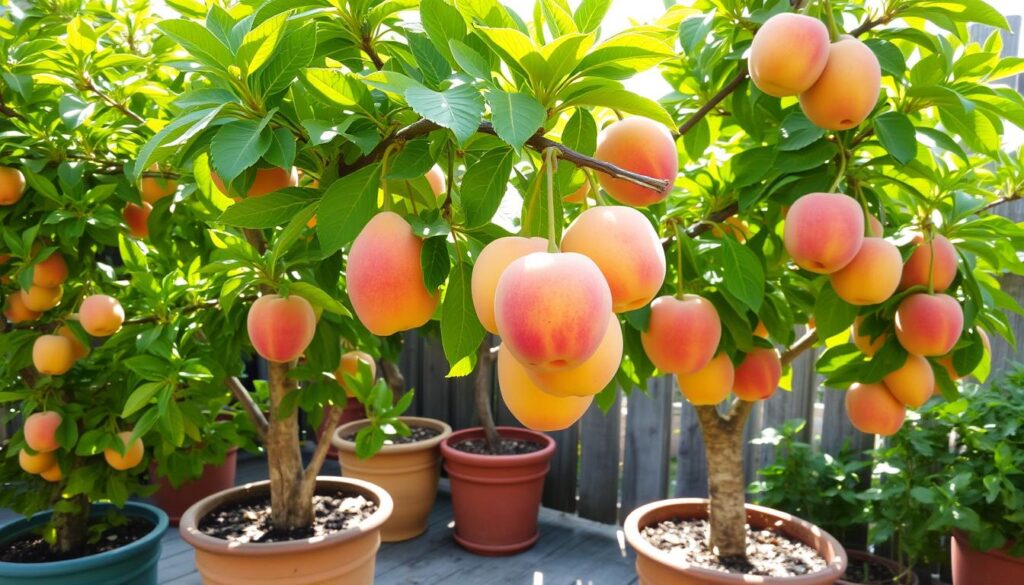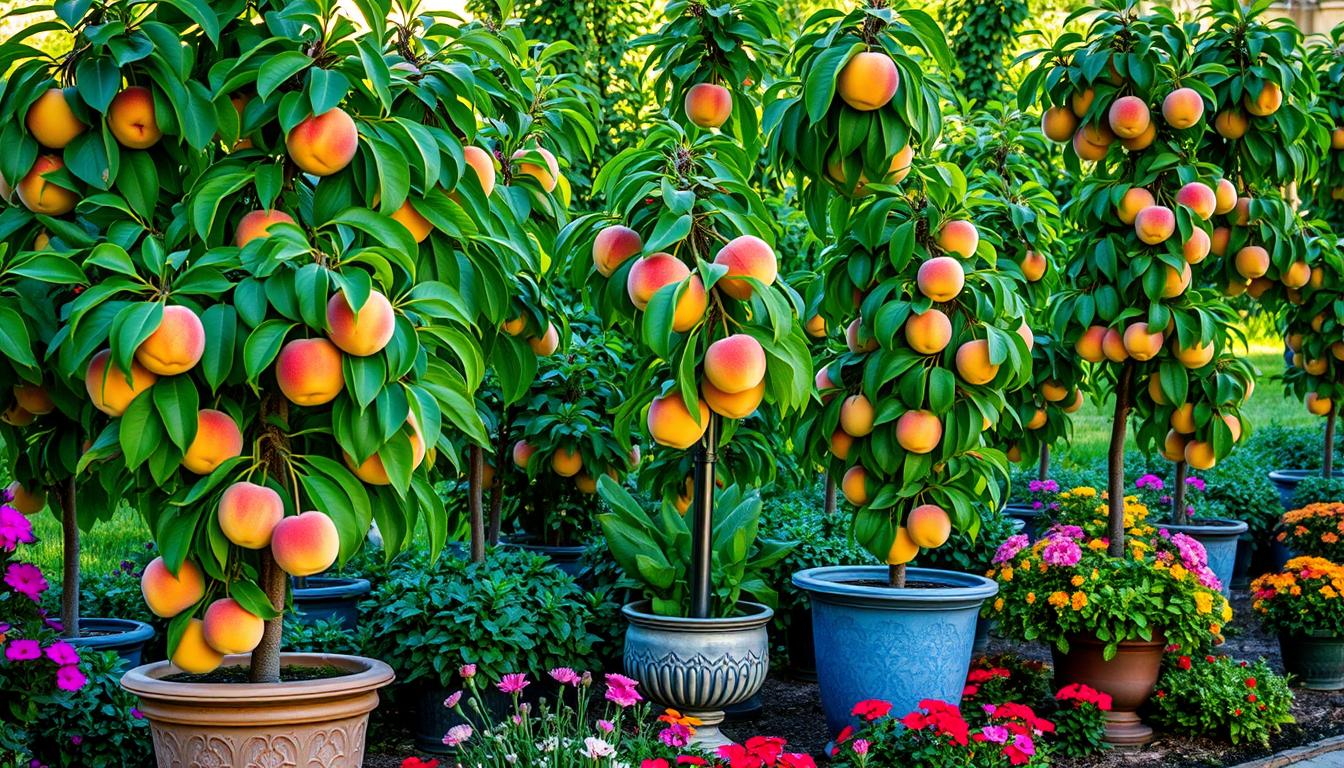Growing your own peaches and nectarines is rewarding, even with little outdoor space. Whether you have a small patio or a balcony, growing these fruits in pots is a great chance to enjoy fresh produce. With the right care and techniques, you can grow delicious fruits in containers.
In this guide, we’ll cover everything from picking the best varieties for container gardening to the care needed for peach and nectarine trees. We’ll share key insights and tips to help you enjoy the fruits of your labor. Learning how to grow peaches and nectarines in containers can make urban gardening more rewarding—join us as we explore the best practices and steps.
For more detailed insights, check out growing peaches and nectarines in containers.
Key Takeaways
- Nectarine trees thrive in warmer conditions and are self-fertile, needing only one tree for a good crop.
- Choose dwarf varieties like ‘Nectarella’ for container planting, reaching around 1.5m (5ft) tall.
- Containers should be at least 45cm (18in) across with peat-free compost, ensuring adequate growing space.
- Regular watering and feeding are crucial for healthy growth and fruit production.
- Protection from frost is vital, particularly in early spring when blossoms are susceptible to damage.
- Thinning fruits when they are hazelnut-sized helps improve their size and quality.
- Peaches and nectarines generally ripen between July and late August, requiring careful monitoring.
Understanding Container Gardening for Fruit Trees
Container gardening is great for growing fruit in small spaces. It lets me grow fruit trees without a big garden. This is perfect for renters or people who move a lot. I can pick dwarf varieties to fit my small space and enjoy fresh fruits.
Dwarf fruit trees are about 2-3 meters tall, fitting well in containers. Super dwarf trees are even smaller, up to 1.5 meters. This means I can grow many fruits in a small area. But, full-sized trees can grow too big, making them hard to care for.
Small fruit trees might cost more than big ones. But, they are easier to care for and fit well in suburban gardens. For beginners, Gardenbeginner.com has great tips to help.
To care for fruit trees in containers, I need to make sure they get enough sunlight. They need at least 5-6 hours of direct sunlight a day. In colder months, I might need to move them indoors, depending on the zone I’m in.
When picking containers, I think about looks, cost, durability, and drainage. Using a good potting mix is key for fruit trees. Good drainage prevents root rot, keeping my plants healthy.
Container gardening has opened up new possibilities for growing fruit in small spaces. I’m looking forward to trying different dwarf and super dwarf fruit trees. I’m excited to learn how to care for them well.
Benefits of Growing Peaches and Nectarines in Containers
Growing peaches and nectarines in containers has many benefits for today’s living. I love how they can adapt to different places. This makes it easy for gardeners like me to grow these tasty fruits, even with little space.
Container-grown trees are smaller, so I can have more on my patio or balcony. Dwarf peach and nectarine trees are only 5 to 6 feet tall and wide. This fits my space well. Standard trees, however, can grow up to 20 feet, which is too big for city homes.
Another plus is moving containers to get more sunlight. This helps the trees grow better. With the right care, my trees can give me 30 to 60 pounds of fruit each year for dwarf varieties. Standard trees can give 100 to 150 pounds.
Container gardening also means less work than traditional orchards. With the right tips, taking care of these trees is easy. They need less water and resources. My efforts not only give me fruit but also make my outdoor area look great.
Choosing the Right Varieties for Container Growth
Choosing the right variety for dwarf fruit tree cultivation is key to growing peaches and nectarines in pots. Look for natural dwarf varieties like Golden Glory peach and Nectar Babe nectarine. These trees grow small but produce full-sized fruits, perfect for container gardens.
It’s important to know the chill hours needed for each variety. Different peaches and nectarines need different cold temperatures for dormancy. So, pick varieties that fit your local climate. For example, Garden Lady or Bonanza Peach are small, reaching only 4 feet tall, ideal for small spaces.

Peach and nectarine trees thrive in USDA zones 4-9. When picking a variety, think about water needs and sun exposure. They need at least 8 hours of direct sunlight and consistent watering, especially when new.
Container size matters too. A minimum of 25 gallons is best for these trees. Opt for self-fertile varieties if space is tight. This way, they can pollinate themselves, eliminating the need for another tree nearby.
By picking the right varieties and considering their needs, growing dwarf fruit trees becomes easier. With the right care, these trees can bring joy and delicious fruits to even the smallest spaces.
How to Grow Peaches and Nectarines in Containers
To grow peaches and nectarines in containers, you need to pick the right size and soil mix. These choices are key to the trees’ health and how well they produce fruit. Knowing what to choose will make your garden grow strong and fruitful.
Selecting the Perfect Container Size
Container size is very important when growing fruit trees in pots. I suggest using a container of at least 25 gallons for peach and nectarine trees. A bigger container means more room for the roots to grow, helping the tree stay healthy.
This size also helps keep the soil moist, which is crucial in hot weather or when it’s dry.
Choosing the Right Soil Mix
For fruit trees, a loamy compost mix is the best. It keeps the soil moist but also lets water drain, preventing root rot. Make sure your container has holes for drainage.
I like to put containers on gravel trays to help with drainage. A good soil mix is essential for the trees to grow well.
| Container Size | Suitable Tree Type | Soil Requirements |
|---|---|---|
| 5 gallons (19 L) | Ideal for smaller or dwarf varieties | Loamy compost blend for moisture retention |
| 25 gallons and above | Best for peach and nectarine trees | Well-draining mix with organic matter |
Choosing the right container size and soil mix is crucial for growing peaches and nectarines in pots. These choices lead to a successful harvest. The journey starts with these important decisions.
Preparing the Container for Planting
Before we start planting peach and nectarine trees in containers, we need to get the container ready. The right setup is key for the trees to thrive. We must ensure good drainage and plant the tree correctly.
Drainage Considerations
Drainage is crucial for container gardening. The container needs enough holes to prevent root rot. If it doesn’t have enough, I drill more holes. Adding gravel or small rocks at the bottom helps with drainage.
When preparing pots, start with good potting soil. It’s different from regular topsoil and supports healthy growth. I fill the container halfway with this soil, then place the tree. Finally, I add more soil just around the graft line.
In summary, good drainage is essential for growing peach and nectarine trees in containers. With careful preparation, these trees will do well on my sunny patio. Regular care will help them grow, bringing beautiful blossoms and delicious fruit soon.
Container Peach Tree Care
Keeping a peach tree in a container healthy needs special care for watering and fertilizing. These steps are key for the tree’s growth and fruit. Let’s look at how to handle these important parts of peach tree care.
Watering Requirements
Watering peach trees in containers is different from planting them in the ground. They need regular watering, especially when it’s hot. Water deeply when the soil’s top layer feels dry.
I usually water every 5 to 7 days in spring. But in the hottest months, I water more often to keep the soil moist. Watching the moisture level is crucial to avoid stressing the tree, which can hurt fruit production.
Fertilization Tips for Container Trees
Fertilizing is also vital for container peach trees. Use a high-phosphorus liquid fertilizer every few weeks in growing season. It helps with flowering and fruiting.
Organic fertilizers like soybean meal or cottonseed meal also work well. Regular fertilizing keeps the tree growing strong, promising a bountiful harvest of peaches.
Container Nectarine Tree Care
Proper care of your nectarine tree in a container is key for its growth and fruit production. Pruning is a crucial part of this care. It helps the tree grow in a healthy shape and get enough light.
Pruning Techniques for Optimal Growth
My goal in pruning nectarines is to shape them like a vase. This makes picking fruit easier. It also helps the branches grow outwards, getting more light. Regular pruning keeps the tree the right size, promoting balanced growth and more fruit.
- Start pruning in late winter or early spring before new growth begins.
- Focus on removing any dead or diseased branches.
- Thin out crowded areas to allow for increased airflow and light penetration.
- Cut back any weak or vertical growth to promote stronger lateral branches.
- Maintain the height of the tree by trimming excessive vertical growth.
If you’re new to pruning, getting help can improve your skills. I often look at resources on nectarines container care to learn more. This careful pruning leads to a healthier, more fruitful tree.
| Pruning Technique | Purpose |
|---|---|
| Remove dead branches | Prevent disease spread and encourage healthy growth. |
| Thin crowded areas | Increase airflow and light exposure. |
| Cut back weak growth | Strengthen the structure of the tree. |
| Maintain height | Control the tree’s size for manageable harvesting. |
Dealing with Pests and Diseases in Containers
Managing pests and diseases in container gardens is crucial. Fruit trees in containers face special challenges, like pests and diseases. Brown rot and peach leaf curl are common diseases that need quick action.
Checking your plants regularly for disease signs is key. Peach leaf curl grows best in cool, wet weather. Good air flow around plants helps prevent infections. Organic treatments work well, especially when flower buds start to show.
Choosing the right fruit tree varieties is important. Some trees are more resistant to diseases than others. For example, trees from dry areas might get bacterial spot in moist places.
I take steps to prevent problems, like picking the right spot and using well-drained soil. Container plants need careful pest control to stay healthy. Pests like plum curculio and oriental fruit moth can harm fruits. Using natural methods or mating disruption helps prevent damage.
Using the right pesticides and starting treatments early helps fight diseases. These practices keep my trees healthy and ensure a good harvest.
Seasonal Care and Maintenance Tips
Seasonal care for fruit trees is key to their health all year. In cold months, I bring my plants inside or to a safe spot to avoid frost. This keeps them strong and ready for spring.
In spring and summer, I watch how much water and food they get. Peach and nectarine trees need lots of water and nutrients when they’re growing fast. I water them about an inch a week to keep the soil right.
When the growing season ends, I water and feed them less. This helps them get ready for sleep. Knowing what each season needs is vital for good fruit.

| Season | Actions | Tips |
|---|---|---|
| Winter | Move containers indoors | Protect from frost; maintain minimal watering |
| Spring | Increase watering and fertilizing | Ensure at least 8 hours of sunlight for optimal growth |
| Summer | Monitor water levels closely | Use drip irrigation systems for efficiency |
| Fall | Reduce watering and fertilizing | Prepare trees for dormancy |
Knowing these patterns helps me give my plants the best care all year. This way, my peach and nectarine trees grow well with little work. For more tips, check out this guide.
Conclusion
Growing peaches and nectarines in containers is rewarding for many. This guide showed how container gardening is great for small spaces. I can grow tasty fruits like the Sensation peach and Arctic Babe nectarine, even with little room.
Learning from other gardeners, we see the importance of choosing the right trees. We also face challenges like local weather. But with the right care and strategies, we can make our trees thrive. This article aims to inspire and help you enjoy gardening at home.
If you’re starting a container garden, remember to have a privacy policy ready. It’s key for any site using tools like Google Analytics. By knowing this, we can have a successful and enjoyable gardening experience.



Leave a Reply